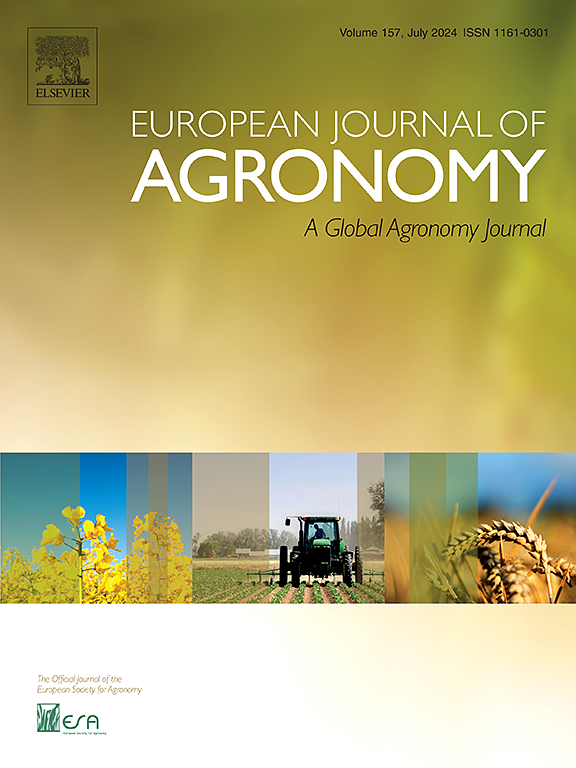利用 CERES-Rice 模型估算中国水稻(Oryza sativa L. )产量及其组成部分的温度敏感性
IF 4.5
1区 农林科学
Q1 AGRONOMY
引用次数: 0
摘要
温度变化对水稻(Oryza sativa L.)产量及其组成部分的影响已被广泛记录。然而,大多数现有研究都是基于小规模、短期的田间试验,很少有大规模或长期的影响评估。在此,我们使用校准过的作物环境资源综合(CERES)-水稻模型对中国主要水稻种植区的六个气候区进行了数值模拟,时间跨度为 1989-2018 年。利用模拟结果,采用面板模型估算了各气候区水稻产量的温度敏感性,并将产量敏感性分解为单位面积圆锥花序数(Pan_no)、每圆锥花序灌浆粒数(Grain_no)和粒重(Grainwt)三部分的温度敏感性。结果表明,所有气候区的水稻产量都表现出负的温度敏感性,在大多数地区主要是由 Grain_no 的温度敏感性驱动的。此外,谷粒重量在所有地区都不随温度变化。进一步分析表明,产量、Pan_no 和 Grain_no 对高温度日 (HDD) 的敏感性高于对生长度日 (GDD) 的敏感性。在温度较高的情况下,HDD 的增加对 Grain_no 的减少起主导作用,而 GDD 和 HDD 的共同作用则导致大多数地区 Pan_no 的增加。然而,温度对 Grain_no 的负面影响超过了对 Pan_no 的正面影响,导致产量下降。这项研究为了解水稻产量及其组成的温度响应提供了深入的见解,将有利于制定有针对性的适应措施,确保水稻在全球变暖条件下的可持续生产。本文章由计算机程序翻译,如有差异,请以英文原文为准。
Estimating the temperature sensitivity of rice (Oryza sativa L.) yield and its components in China using the CERES-Rice model
The effects of temperature changes on rice (Oryza sativa L.) yield and its components have been widely documented. However, most existing studies are based on small-scale, short-term field experiments, with few assessing these effects on a large scale or over long periods. Here, the calibrated Crop Environment Resource Synthesis (CERES)-Rice model was used for numerical simulations over six climate regions in the major rice cultivation areas of China for the period of 1989–2018. The simulated results were used to estimate the temperature sensitivity of rice yield with a panel model in each climate region, and the yield sensitivity was then decomposed into the temperature sensitivity of three components: panicle number per unit area (Pan_no), filled grain number per panicle (Grain_no), and grain weight (Grainwt). Results indicated that rice yield exhibited negative temperature sensitivity across all climate regions, driven primarily by the temperature sensitivity of Grain_no in most regions. Additionally, Grainwt did not vary with temperature in all regions. Further analysis suggested that yield, Pan_no, and Grain_no were more sensitive to high temperature degree days (HDD) than to growing degree days (GDD). Under the warmer scenarios, HDD increase played a dominant role in the reduction of Grain_no, while the joint effect of GDD and HDD resulted in an increased Pan_no in most regions. However, the negative effect of temperature on Grain_no outweighed its positive effect on Pan_no, leading to a decline in yield. This study provides insight for understanding the temperature response of rice yield and its components and will be beneficial for developing targeted adaptations to ensure rice sustainable production under global warming.
求助全文
通过发布文献求助,成功后即可免费获取论文全文。
去求助
来源期刊

European Journal of Agronomy
农林科学-农艺学
CiteScore
8.30
自引率
7.70%
发文量
187
审稿时长
4.5 months
期刊介绍:
The European Journal of Agronomy, the official journal of the European Society for Agronomy, publishes original research papers reporting experimental and theoretical contributions to field-based agronomy and crop science. The journal will consider research at the field level for agricultural, horticultural and tree crops, that uses comprehensive and explanatory approaches. The EJA covers the following topics:
crop physiology
crop production and management including irrigation, fertilization and soil management
agroclimatology and modelling
plant-soil relationships
crop quality and post-harvest physiology
farming and cropping systems
agroecosystems and the environment
crop-weed interactions and management
organic farming
horticultural crops
papers from the European Society for Agronomy bi-annual meetings
In determining the suitability of submitted articles for publication, particular scrutiny is placed on the degree of novelty and significance of the research and the extent to which it adds to existing knowledge in agronomy.
 求助内容:
求助内容: 应助结果提醒方式:
应助结果提醒方式:


